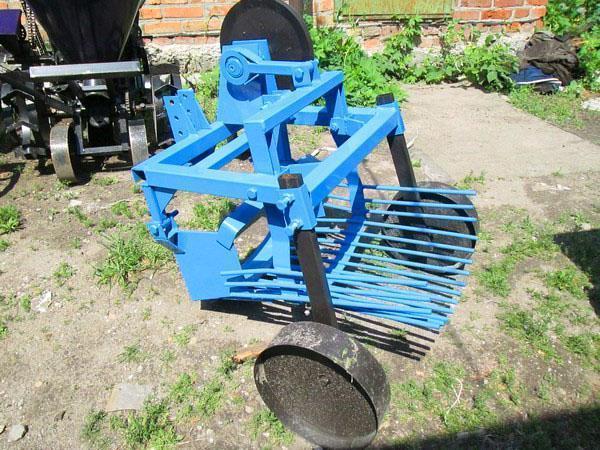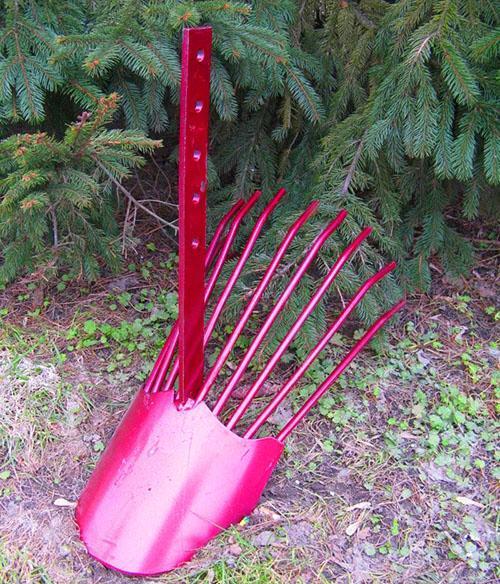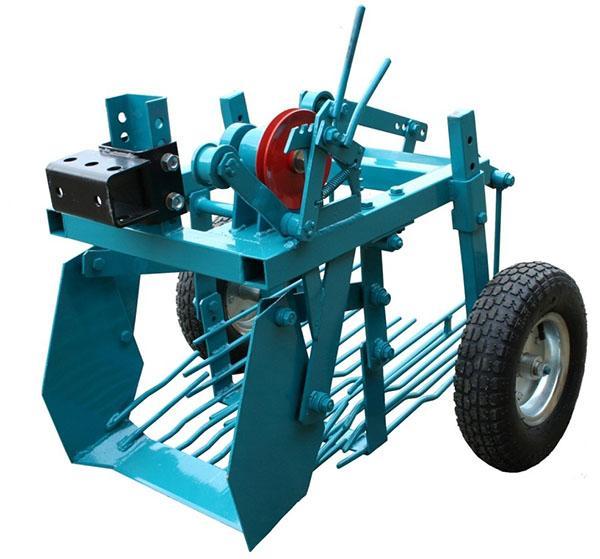A potato digger for a walk-behind tractor will help to quickly and efficiently harvest
 A walk-behind tractor is used for harvesting potatoes in small and medium-sized areas. A potato digger for a walk-behind tractor is a mandatory equipment in this case, because agricultural work is unthinkable without special tools, devices and equipment. The hard times of manual labor are a thing of the past.
A walk-behind tractor is used for harvesting potatoes in small and medium-sized areas. A potato digger for a walk-behind tractor is a mandatory equipment in this case, because agricultural work is unthinkable without special tools, devices and equipment. The hard times of manual labor are a thing of the past.
Any model of a potato digger has the same operating principle. Its principle should be described as follows: teeth or twigs, plunging into the ground, reach tuber by tuber on the surface. Each potato rises from the nest and is hand-picked very quickly.
Types of potato diggers

- Simple potato digger. Conventional shovel or plow attachments with welded rods or tines. Plow - the shovel cuts into the soil, lifting ripe fruits outward along the teeth. It turns out that excess land is sifted out from root crops in the process of loosening and lifting the soil. All tubers from the nest remain at the top. The peculiarity of a simple potato digger is that it is installed on any walk-behind tractor or a small tractor of any power.
- Vibrating potato digger. This is a conveyor potato digger for a walk-behind tractor. Equipped with a sieve grate or grates that fit on the support wheels. The design also includes a share. In the process of plowing, the soil is cut through, then it rises along with the root crops to the lattice. On the grate, potatoes are sifted from the ground and tops. Further, the roots fall along the lattice to the surface of the site. In the end, it is easy to harvest the crops in the bags from the potato digger.

Agricultural equipment of this type is produced under different brands, it has several types of fasteners. Before purchasing, it is better to make sure that the device will fit your cultivator model.
Several main popular models for cultivators:
- The usual "KKM-1".
- The usual "KVM-3".
- The usual "Garden Scout".
- Vibration "Neva".
- Vibration "Poltavchanka".
The price of a potato digger for a walk-behind tractor from this list varies from 7,000 to 12,500 rubles. In the summer season, prices, of course, can increase.
It is important that the listed models of potato diggers will exactly fit the type of attachment to walk-behind tractors:
- "Salute".
- "Neva".
- MTZ.
Homemade potato digger for walk-behind tractor
It is worth making a manual potato digger for compact areas. Industrial types of equipment for large areas are best bought from manufacturers.
Simple vibration equipment is easy to make from the following materials:
- Iron channel.
- The piece is no thinner than 5 millimeters. Strong steel is required for the share. A used circular blade or any other high-speed steel is perfect.
- Iron corners from rolled metal products.
- Steel or iron bars. It is better to use fittings with a small diameter.
The vibration model must be made from a base or frame. The design must include:
- base (the aforementioned frame);
- suspension system;
- adjustment rods;
- moving elements (wheels or lugs).
Drawing of a vibrating potato digger for a walk-behind tractor:
Necessary tools
Can't do without:
- grinders;
- welding machine;
- engraver or drill;
- square and level;
- mounting plates;
- steel bolts with nuts.
Vibration model creation
Rules for making each part separately and assembling the entire mechanism.
The foundation
It is optimal to use a 40 x 40 mm square profile pipe. It is better to take a 4-meter billet in rolled metal and divide it into segments of 120 and 80 centimeters. We get four support beams.
Of these, you need to weld the base in the form of a rectangle at a right angle. Its dimensions will be 120 by 80 centimeters.
Mount for rods
 It is necessary to weld jumpers not in the middle of the frame (rectangle), but at a quarter of its length.
It is necessary to weld jumpers not in the middle of the frame (rectangle), but at a quarter of its length.
On the reverse side of the base, we fix the square tubes in a vertical position by welding. They are located outside the base for mounting the axis. Wheels are subsequently installed on the axle.
Drill or an engraver makes a 1 centimeter hole in a place convenient for fastening.
Vertical racks
We retreat 5 centimeters from the edge of the frame and weld the square profile. Its length is no more than 50 centimeters. After 15-20 cm, we also fix the square profile by welding, but already 40 centimeters long. After the second rack, we measure 40 centimeters and fix the 30 centimeters profile by welding.
As a result, the design looks like a metal pair of descending stairs.
Rigidity for racks
You need to fix the racks at the bottom of the structure. For this, a strip of metal of 0.4 - 0.5 mm is used. The posts should be welded at 45 degrees, additionally welding the strips together.
Ploughshare or Ralo
 Creation of the working part of the potato digger. Homemade plowshares should sink into the soil, digging in the potato rows for harvesting.
Creation of the working part of the potato digger. Homemade plowshares should sink into the soil, digging in the potato rows for harvesting.
To make a Ralo, you need metal from 0.3 mm thick. Two "working" blades are cut out according to the drawing and a homemade plow is welded. To give a volumetric shape, convenient for gripping the soil, you need to tap the center of the blades with a hammer, having previously secured the entire structure with a fixing rod.
Pitched board manufacturing
 The pitched board is a continuation of the design of the potato digger, or rather steel rods welded to the base. The easiest way is to use reinforcing bars with diameters of no more than 10 mm, up to 120 centimeters long. Every 4-5 centimeters, you need to weld the reinforcement, as shown in the photo.
The pitched board is a continuation of the design of the potato digger, or rather steel rods welded to the base. The easiest way is to use reinforcing bars with diameters of no more than 10 mm, up to 120 centimeters long. Every 4-5 centimeters, you need to weld the reinforcement, as shown in the photo.
Adjustment rods
Optional element, because adjustment is only needed on problem (watery) soil.
The rods can easily adjust the desired angle to tilt the reinforcing (pitched) board. The easiest way is to make a movable structure in the form of a frame, on which the pitched board is located. The frame is tightened with conventional bolts.
Support wheels
The construction of a digger for a walk-behind tractor, created by hand, must be equipped with movable wheels for ease of operation and movement.
It is most advantageous to equip the digger with wheels from a garden wheelbarrow with a wide tire. We acquire axles, fix them to the frame and install the wheels. It is easier to fix the wheels with a hairpin (as in a garden wheelbarrow device).
The simplest potato digger for a walk-behind tractor
 The lancet type potato digger is the simplest type of attachment for cultivator... Manufacturing does not require special materials, complex drawings and measurements.
The lancet type potato digger is the simplest type of attachment for cultivator... Manufacturing does not require special materials, complex drawings and measurements.
You will need a bipod, but it is easy to cut, for example, from an old shovel. Make rods from reinforcement or adapt teeth from old forks. A thrifty owner will always find use even for old broken garden tools.
To successfully use homemade equipment, you need to know the degree of soil density on the site. Otherwise, the use of such a potato digger will become inconvenient.
Simply attach to any model of cultivator or mini-tractor. There are no movable units in the structure, so there is nothing to break.